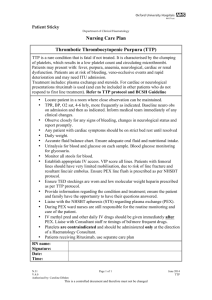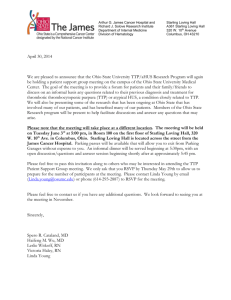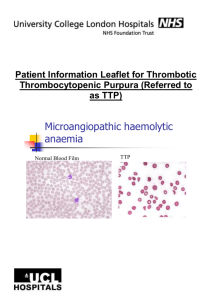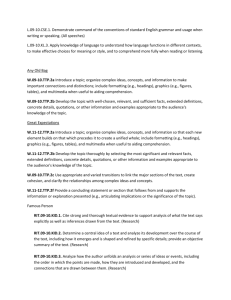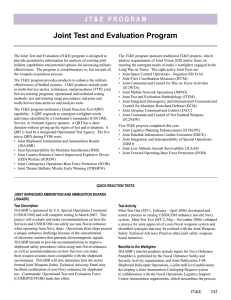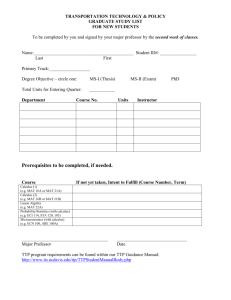Joint Test and Evaluation Program
advertisement
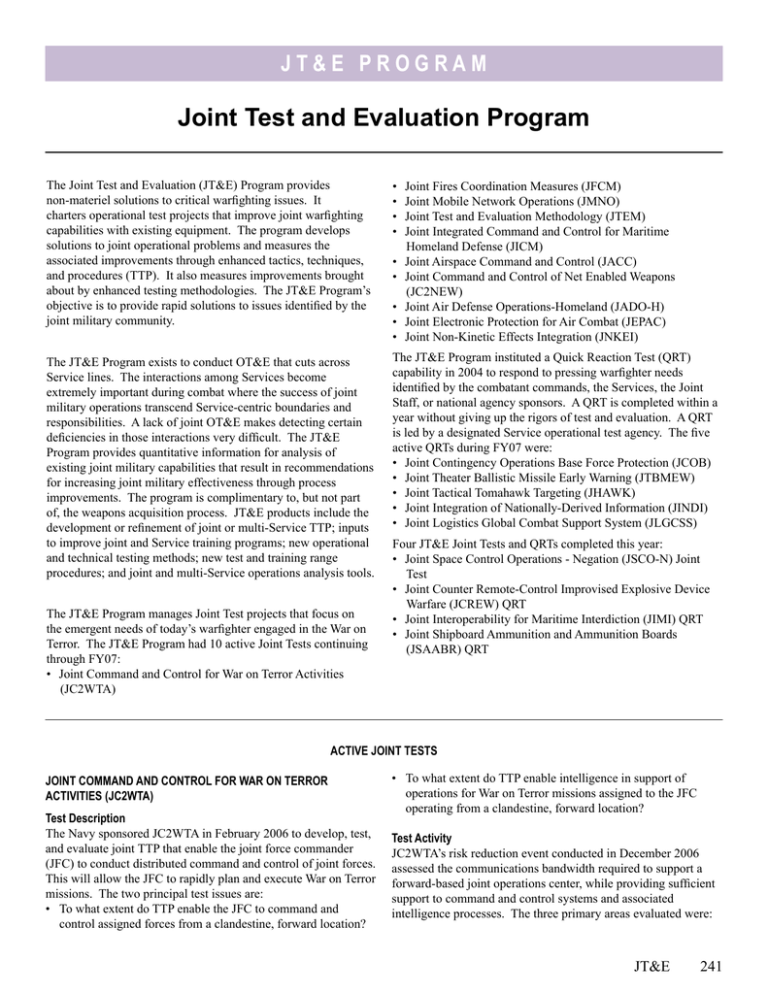
JT&E PROGRAM Joint Test and Evaluation Program The Joint Test and Evaluation (JT&E) Program provides non-materiel solutions to critical warfighting issues. It charters operational test projects that improve joint warfighting capabilities with existing equipment. The program develops solutions to joint operational problems and measures the associated improvements through enhanced tactics, techniques, and procedures (TTP). It also measures improvements brought about by enhanced testing methodologies. The JT&E Program’s objective is to provide rapid solutions to issues identified by the joint military community. The JT&E Program exists to conduct OT&E that cuts across Service lines. The interactions among Services become extremely important during combat where the success of joint military operations transcend Service-centric boundaries and responsibilities. A lack of joint OT&E makes detecting certain deficiencies in those interactions very difficult. The JT&E Program provides quantitative information for analysis of existing joint military capabilities that result in recommendations for increasing joint military effectiveness through process improvements. The program is complimentary to, but not part of, the weapons acquisition process. JT&E products include the development or refinement of joint or multi-Service TTP; inputs to improve joint and Service training programs; new operational and technical testing methods; new test and training range procedures; and joint and multi-Service operations analysis tools. The JT&E Program manages Joint Test projects that focus on the emergent needs of today’s warfighter engaged in the War on Terror. The JT&E Program had 10 active Joint Tests continuing through FY07: • Joint Command and Control for War on Terror Activities (JC2WTA) • • • • • • • • • Joint Fires Coordination Measures (JFCM) Joint Mobile Network Operations (JMNO) Joint Test and Evaluation Methodology (JTEM) Joint Integrated Command and Control for Maritime Homeland Defense (JICM) Joint Airspace Command and Control (JACC) Joint Command and Control of Net Enabled Weapons (JC2NEW) Joint Air Defense Operations-Homeland (JADO-H) Joint Electronic Protection for Air Combat (JEPAC) Joint Non-Kinetic Effects Integration (JNKEI) The JT&E Program instituted a Quick Reaction Test (QRT) capability in 2004 to respond to pressing warfighter needs identified by the combatant commands, the Services, the Joint Staff, or national agency sponsors. A QRT is completed within a year without giving up the rigors of test and evaluation. A QRT is led by a designated Service operational test agency. The five active QRTs during FY07 were: • Joint Contingency Operations Base Force Protection (JCOB) • Joint Theater Ballistic Missile Early Warning (JTBMEW) • Joint Tactical Tomahawk Targeting (JHAWK) • Joint Integration of Nationally-Derived Information (JINDI) • Joint Logistics Global Combat Support System (JLGCSS) Four JT&E Joint Tests and QRTs completed this year: • Joint Space Control Operations - Negation (JSCO-N) Joint Test • Joint Counter Remote-Control Improvised Explosive Device Warfare (JCREW) QRT • Joint Interoperability for Maritime Interdiction (JIMI) QRT • Joint Shipboard Ammunition and Ammunition Boards (JSAABR) QRT ACTIVE JOINT TESTS Joint Command and Control for War on Terror Activities (JC2WTA) Test Description The Navy sponsored JC2WTA in February 2006 to develop, test, and evaluate joint TTP that enable the joint force commander (JFC) to conduct distributed command and control of joint forces. This will allow the JFC to rapidly plan and execute War on Terror missions. The two principal test issues are: • To what extent do TTP enable the JFC to command and control assigned forces from a clandestine, forward location? • To what extent do TTP enable intelligence in support of operations for War on Terror missions assigned to the JFC operating from a clandestine, forward location? Test Activity JC2WTA’s risk reduction event conducted in December 2006 assessed the communications bandwidth required to support a forward-based joint operations center, while providing sufficient support to command and control systems and associated intelligence processes. The three primary areas evaluated were: JT&E 241 JT&E PROGRAM 1) bandwidth requirements to effectively support a clandestine, forward command center, 2) the applicability of the draft TTP under simulated field conditions, and 3) the overall success using a wargame as a risk reduction event. The risk reduction event achieved all three primary objectives. JC2WTA conducted Field Test 1 with the Special Operations Command, Pacific at the Talisman Saber exercise in June 2007. This test exercised the planning staff of a combined joint special operations task force, forcing them to work together closely in developing a plan to deploy a distributed, forward command center. Benefits to the Warfighter The JC2WTA-developed TTP (interim TTP distributed in August 2007, final version expected in June 2008) will support the JFC to conduct distributed command and control of warfighters engaged in the War on Terror from a small, forward-deployed platform using limited communications bandwidth. Joint Fires Coordination Measures (JFCM) Test Description The Air Force sponsored JFCM in February 2005 to improve the effectiveness of joint fires areas (JFAs) by establishing standardized TTP. JFCM’s two principal test issues are: • To what extent do JFCM developed-TTP enable the JFC to plan and establish a JFA? • To what extent do the current or near-term communications systems and command and control systems enable the JFC to plan and establish a JFA with JFCM-developed TTP? Test Activity The third phase of JFCM’s four phase test plan was completed during FY07 as JFCM analyzed data from two mini-tests and issued test event reports for both of these events. JFCM began Phase IV, which consists of a risk-reduction event, a live field test, and final product transition. Phase IV’s objective is to determine whether the refined JFA TTP and supporting communication systems and command and control processes will meet warfighter needs in a realistic, joint combat environment. The test team conducted the risk reduction event in March 2007 and the field test in August 2007. Initial review of the data from the test demonstrated that the JFCM-developed JFA TTP and supporting communication systems and command and control architecture can be used to effectively establish JFAs for both joint and combined forces. JFCM began detailed planning for JFA TTP transition into appropriate doctrinal publications. JFCM is scheduled to close on December 31, 2007. Benefits to the Warfighter JFCM provides TTP that enables the JFC to integrate fires in support of a campaign plan and provides sea, land, and air component courses of action without further coordination with the establishing authority. The JFA TTP standardizes a fire support coordination measure that not only integrates fires, but also integrates components. JFA TTP, published in December 242 JT&E 2007, enables the components to use existing communication systems and command and control processes to more effectively and efficiently integrate fires with maneuver elements, while reducing the risk of fratricide. Joint Mobile Network Operations (JMNO) Test Description The Marine Corps sponsored JMNO in February 2006 to identify, test, and recommend network operations procedures that enhance interoperability of mobile networks employed in joint operations. JMNO will develop joint TTP to improve the joint forces’ ability to access information and network services when crossing from one network to another. The two test issues are: • What is the level of network interoperability achieved between different Services at the tactical level? • To what extent do JMNO-developed mobile network operations TTP enable a tactical user to access information resources and network services via a different Service’s network? Test Activity JMNO completed its research of each Service’s mobile network operations and developed an initial, mobile network operations TTP. JMNO also conducted a Joint User Interopable Communications mini-test to determine the TTP’s acceptability to meet the JMNO test issues. Benefits to the Warfighter JMNO will validate mobile network operations TTP that will: • Integrate tactical and Service component networks • Improve mobile network access and maintain current performance • Enhance user connectivity to the user’s information resources while maneuvering through the battlespace • Enable interoperability and information assurance between different Services’ networks • Provide input to future concepts employing mobile network operations on the asymmetric battlefield • Maintain quality of service across network boundaries Joint Test and Evaluation Methodology (JTEM) Test Description DOT&E sponsored JTEM in February 2006 to develop processes and test methods for operational testing in a joint environment. Specifically, JTEM is developing and evaluating methods and processes for defining and using a distributed live, virtual, constructive joint test environment to evaluate system performance and joint mission effectiveness. The three principal test issues are: • How effective are the proposed methods and processes for designing and executing tests of a system-of-systems in the joint mission environment? • How suitable are the proposed methods and processes for designing and executing tests of a system-of-systems in the joint mission environment? JT&E PROGRAM • How effective are the proposed methods and processes for assessing performance as it pertains to capabilities supporting joint missions? Test Activity JTEM conducted two major test events in 2007. The first test was a gap analysis event conducted with the Net Enabled Command Capability Program within the Defense Information Systems Agency to determine if the procedures set by JTEM and the Net Enabled Command Capability Program documented all the necessary steps to conduct testing in a joint environment. Following the gap analysis, JTEM conducted its first full-scale field test in August 2007. The test evaluated JTEM methods and processes when used by typical test organizations under realistic conditions in order to evaluate the suitability of the methods and processes for testing in a joint mission environment. JTEM is scheduled to close on April 30, 2009. Benefits to the Warfighter JTEM will deliver processes and test methodologies that institutionalize testing in a joint mission environment. JTEM’s Capability Test Methodology v.2 is expected to be published in February 2008, with the final version ready for release in March 2009. Additionally, JTEM test products will include method and process templates, handbooks for the testing and acquisition communities, recommended changes to the acquisition instructions, and directives that will facilitate testing in a joint environment. Joint Integrated Command and Control for Maritime Homeland Defense (JICM) Test Description The Northern Command (NORTHCOM) sponsored JICM in March 2006 to evaluate command and control (C2) processes to execute NORTHCOM maritime homeland defense missions. The test is focused on maritime C2 TTP, for both DoD and non‑DoD agencies, from the strategic to the operational level. The principal test issue is: • To what extent does the JICM Maritime Homeland Defense Command & Control Handbook support maritime threat response C2 within the NORTHCOM area of responsibility? Test Activity The team conducted Field Test 1 during Vigilant Shield 2007 to assess the “as is” maritime homeland defense C2 processes to create a baseline for future test comparisons. Field Test 2 encompassed Ardent Sentry/Northern Edge 2007 and Frontier Sentinel 2007. During these exercises, the team assessed the impact of the JICM test article on C2 processes in response to maritime threats and collected data on Canadian maritime responses. JICM is scheduled to close in September 2008. Benefits to the Warfighter JICM will provide recommendations to improve DoD and intergovernmental C2 interoperability, maritime concept of operations, and joint and integrated TTP for responding to a maritime threat. The JICM test products include the Maritime C2 Handbook, Maritime Threat Response Checklist, Maritime Threat Response C2 Business Rules, and the Maritime Threat Response Portal. JICM is working within NORTHCOM to develop a joint mission essential task for maritime C2 processes. Joint Airspace Command and Control (JACC) Test Description The Army sponsored JACC in August 2006 to provide more lethal access to joint airspace for surface and airborne sensors, weapons, and C2 systems to carry out missions generated in support of forward operating bases (FOB) and maneuver elements. The principal test issues are: • To what extent are the joint airspace C2 processes effective in supporting immediate missions generated in support of FOBs and maneuvering elements? • To what extent are the joint airspace C2 processes acceptable to support immediate missions generated in support of FOBs and maneuvering elements? Test Activity JACC will conduct its testing at Joint Forces Command’s Unified Endeavor exercise and the Joint Readiness Training Center. JACC will conduct a risk reduction event in FY08 to assess and validate its data collection plan. Benefits to the Warfighter JACC plans to deliver airspace C2 process enhancements to the warfighter that will improve execution of missions needing access to the joint airspace. JACC will deliver an interim product after Field Test 1 that will describe and clarify current joint airspace C2 procedures. The second version of the handbook will contain enhanced C2 procedures that will be tested in Field Test 2. The final version of the handbook will be distributed after JACC assesses the results of Field Test 2. Joint Command and Control for Net Enabled Weapons (JC2NEW) Test Description The Air Force sponsored JC2NEW in August 2006 to address the concept of operations (CONOPS), processes, and procedures for employment of net enabled weapons (NEW) in the net-centric battlespace. The objective of NEW is to improve the JFC’s capabilities in precision engagement, particularly for targets that require immediate attention. The ability of intelligence, surveillance, reconnaissance systems and command and control processes to support net-centric weapons employment has not been determined, which severely degrades the JFC’s ability to effectively use this capability. The principal test issues are: • To what extent do JC2NEW-developed CONOPS and TTP support command and control of NEW employment against dynamic targets in maritime operations? JT&E 243 JT&E PROGRAM • To what extent do JC2NEW-developed CONOPS and TTP support command and control of NEW employment against dynamic targets in ground operations? Test Activity JC2NEW participated in Valiant Shield 2007 focusing on the integration of the Combined Air Operations Center Performance Assessment System, an analysis tool, into the Bong Air Operations Center at Hickam AFB, Hawaii. This test activity provides the baseline for JC2NEW’s first field test in Northern Edge 2008. Benefits to the Warfighter JC2NEW will have an interim TTP ready by August 2008. The final version is expected to be ready in August 2009. Other expected benefit includes the ability to: • Precisely engage moving and stationary surface targets in all anticipated operational scenarios while minimizing risks to operators, friendly ground forces, and noncombatants • Provide the JFC with the responsiveness and flexibility to dynamically respond to time-sensitive targets and changing priorities • Increase attack confidence, thereby minimizing a friendly force’s exposure to threats and to help reduce resource expenditures Joint Air Defense Operations-Homeland (JADO-H) Test Description The Army’s Space and Missile Defense Command / Army Forces Strategic Command, NORAD, and NORTHCOM sponsored JADO-H in August 2007 to test and evaluate deployable homeland air and cruise missile defense (D-HACMD) TTP to improve the planning process. JADO-H will collect, collate, and analyze D-HACMD planning TTP and refine processes and procedures to formalize the TTP. The principal test issues are: • To what extent do formalized D-HACMD planning TTP enable effective use of combined force air and cruise missile defense capabilities to support defeating asymmetric aerial threats directed against a defended asset? • To what extent do formalized D-HACMD planning TTP enable effective use of interagency air and cruise missile defense capabilities to support defeating asymmetric aerial threats directed against a defended asset? Test Activity The test team began work in September 2007 by forming combined and interagency working groups. JADO-H will conduct a risk reduction event and a mini-test in FY08. Benefits to the Warfighter JADO-H will provide a set of collaborative tools that will standardize interagency planning. The collaborative tools will include D-HACMD process modeling, operational architecture enhancements, an exercise planning guide, a commander’s planning handbook, and joint TTP. 244 JT&E Joint Electronic Protection for Air Combat (JEPAC) Test Description The Air Force sponsored JEPAC in August 2007 to develop joint TTP to improve combat effectiveness through the use of electronic protection via timely integration of specific target track generating capabilities with tactical shooters during combat employment. The principal test issues are: • To what extent does the JEPAC-developed TTP enable the warfighter to recognize he is operating in the presence of advanced electronic attack (EA) waveforms? • To what extent does the JEPAC-developed TTP enable the warfighter’s ability to rebuild key targeting data in the presence of advanced EA waveforms? • To what extent does the JEPAC-developed TTP enable the warfighter’s ability to prosecute the primary threat in the presence of advanced EA waveforms? Test Activity JEPAC formed its test team in September 2007, convened a joint warfighter advisory group, and held tabletop exercises. The first field test is scheduled in mid-FY08 during Northern Edge 2008. Benefits to the Warfighter During the course of its testing, JEPAC will deliver interim products to the warfighter that will protect him from advanced EA. These interim products are expected to be new advanced EA joint TTP for publication in July 2008 and a revised version in July 2009; recommendations to update Service and joint advanced EA training; recommendations to improve data link system architectures in support of advanced EA missions; and inputs to support U.S. Pacific Command (PACOM) contingency and operations plans. The final EA joint TTP is expected to be published in mid-2010. Final products will also include recommended changes to Service and joint doctrinal publications. Joint Non-Kinetic Effects Integration (JNKEI) Test Description The Strategic Command (STRATCOM) sponsored JNKEI in August 2007 to focus on offensive non-kinetic information operations capabilities that include EA, computer network attack (CNA), and space control-negation (SC-N) to affect adversary systems through manipulation of the electromagnetic spectrum. The principal test issue is: • To what extent does JNKEI-developed TTP enable the JFC to integrate EA, CNA, and SC-N capabilities within crisis action planning? Test Activity JKNEI formed its test team in September 2007. The team will host a joint warfighter meeting to develop a draft TTP and conduct tabletop exercises in early FY08 to be used during JNKEI’s first mini-test. JT&E PROGRAM Benefits to the Warfighter JNKEI will develop planning interim TTP that integrate EA, CNA, and SC-N operations into the JFC’s planning process expected to be published in December 2008. Specifically, JKNEI will develop joint and Service training packages that support non‑kinetic integration planning; publish the Commander’s Handbook for Non-Kinetic Integration Planning; and the Intelligence Support to Non-Kinetic Integration Handbook. JNKEI will also recommended changes to Service and joint doctrinal publications. These final products and a final version of the TTP are expected to be published in May 2010. ACTIVE QUICK REACTION TESTS Joint Contingency Operations Base (JCOB) Test Description The Army sponsored JCOB in August 2006 to develop joint TTP to improve the set up of U.S. camps housing security, stability, transition, and reconstruction operations. This TTP enhances security, streamlines camp set-up, and allows military units to focus on their assigned mission. The Army’s Test and Evaluation Command leads this effort. Test Activity The test team collected the data needed for analysis of the early warning system in March 2007. The next phase of the test produced a report on the analysis of the data and a draft early warning system operator’s handbook. The handbook was evaluated during Ulchi Focus Lens 2008 in August 2007 and a final handbook will be published after the revisions are incorporated. The project closed in October 2007. Test Activity Testing occurred from April-June 2007. Testing included anti-terrorist and force protection measures such as vehicle inspections, interior and exterior protection barriers, and small observation and fighting positions. In August 2007, the JCOB test team observed and conducted research at counter-rocket, -artillery, and -mortar exercises. Additionally, the test team reviewed best practices of units in theater and input from the JCOB subject matter expert working group. The project closed in October 2007. Benefits to the Warfighter The JTBMEW operator’s handbook, published in October 2007, standardizes the use of the complex early warning system to increase confidence and accuracy in warnings. The JTBMEW project will provide full documentation of the existing tactical ballistic missile early warning system architecture (all platforms and reporting methods) and will add radio frequency data sources. This will result in increased accuracy of launch and impact predictions. Benefits to the Warfighter JCOB produced a handbook for defense of contingency operations bases that gives guidance on: site selection, perimeter security, standoff, dispersion, compartmentalization, sidewall protection, and overhead cover against the threat of improvised explosive devices (IEDs), rockets, artillery, mortars, and vehicle‑borne IEDs in Iraq and Afghanistan. JCOB recommended changes to joint publications for contingency operations base defense. It also published a final report that identifies the gaps in current base defenses. The Army distributed the handbook to units presently in Iraq and Afghanistan and to training units in the United States in November 2007. Test Description The Special Operations Command and the Commander, Second Fleet co-sponsored JHAWK in April 2007 to evaluate and recommend multi-Service TTP for employment of the Tactical Tomahawk Weapon System by special operations and other expeditionary forces. The Navy’s Commander, Operational Test and Evaluation Force is the lead operational test agency. The principal test issues are: • Determine the in-place C2 structure and systems used in the approval of short response strikes • Determine the optimal C2 structure necessary to satisfy all theater targeting and engagement approval requirements • Determine courses of action to alternative C2 structures and procedures to reduce timelines in support of meeting mission objectives • Develop and document recommended procedures for early assessment and operational trial Joint Theater Ballistic Missile Early Warning (JTBMEW) Test Description The Army sponsored JTBMEW in August 2006 to develop joint TTP that enhances precise theater ballistic missile early warning to the Combined Forces Command. This test will examine the Korean theater of operations’ ballistic missile early warning architecture to determine weaknesses involving all platforms and current methods of information collection, processing, and dissemination. The Army’s Test and Evaluation Command leads this effort. Joint Tactical Tomahawk Targeting (JHAWK) Test Activity JHAWK’s prime data collection opportunities are Tomahawk missile operations during the Greyhound Express series of exercises. Greyhound Express 07-1 (June 2007) served as a risk reduction event that allowed test planners to rehearse their JT&E 245 JT&E PROGRAM data collection, storage, and manipulation activities. Greyhound Express 08-1, tentatively scheduled for fall 2007, will be the primary data collection opportunity for JHAWK. The draft TTP will be validated during this event. Any modifications determined to be needed will be incorporated in the final version of the TTP. The project is scheduled to close in April 2008. Benefits to the Warfighter JHAWK’s interim TTP were distributed in June 2007. JHAWK will deliver a final, executable TTP in February 2008 for the tactical use of the Tomahawk Land Attack Missile in striking time-sensitive targets associated with the War on Terror. The JHAWK TTP will formalize Tomahawk third-party targeting for units such as special operations teams. Joint Integration of Nationally-Derived Information (JINDI) Test Description The Air Force Warfare Center sponsored JINDI, with support from PACOM, to evaluate and recommend improvements to current methods used to provide nationally-derived information from regional cryptologic centers to front-line forces. The Air Force Joint T&E Program Office leads this effort. The principal test issues are: • Can dependable Link 16 (a data link) architectures be developed to provide a beyond line-of-sight capability to provide timely information to distant front-line forces? • Can this dependable Link 16 architecture be used to provide the cryptologic centers with real-time tactical information to enable more focused support of a tactical situation? • Can the JINDI-developed TTP provide timely information to the tactical users to support command and control, tactical deconfliction, and targeting? Test Activity JINDI’s initial test was during Valiant Shield 2007 in August 2007. JINDI established tactical data link connectivity between a regional cryptologic center and tactical assets participating in the exercise. Using JINDI-developed TTP, exercise participants within the regional cryptologic centers were able to view the tactical picture from front-line forces and inject nationally‑derived data into the exercise data link to directly support tactical forces. Further tests will utilize regional cryptologic centers daily operations to further validate and refine the JINDI capability and associated TTP. The project is scheduled to close in April 2008. Benefits to the Warfighter JINDI will test and validate TTP designed to increase situational awareness for the warfighter by incorporating unique, actionable, and sanitized intelligence into the Link 16, a common tactical data link. The TTP will also benefit the national intelligence community by providing methodologies for the receipt of near real-time tactical information for more focused collection strategies and priorities. An interim TTP was published in August 2007; the final version is expected to be published in March 2008. Joint Logistics Global Combat Support System (JLGCSS) Test Description The Joint Staff J4 sponsored JLGCSS in April 2007 to develop Global Combat Support System (GCSS) TTP to enable the joint warfighter to fully leverage GCSS capabilities to enhance joint force reception processes and workflows; make GCSS capability improvement recommendations; and develop a GCSS training strategy. This QRT will better enable the JFC to leverage GCSS capabilities to sustain joint logistics readiness. The Army’s Test and Evaluation Command leads this effort. Test Activity The test team began the review and analysis of joint force reception doctrinal publications in May 2007. From July to September 2007, force reception processes and workflows were documented at PACOM, Central Command, Southern Command, and U.S. Forces Korea to establish a valid representation across combatant commands. The test includes a risk reduction event in which the TTPs will be reviewed by experts, followed by a field test in which PACOM and U.S. Forces Korea test the TTPs in a realistic environment. The project is scheduled to close in April 2008. Benefits to the Warfighter Updated, standardized TTP will improve a warfighter’s use of GCSS capabilities in support of personnel and materiel arriving into, moving through, or leaving an area of operation. The QRT will also report gaps in GCSS v6.1 capabilities to the GCSS-J Program Manager for inclusion in future upgrades to GCSS software. Finally, the QRT will develop a training strategy that provides an overview of GCSS capabilities to leaders, as well as more detailed operator-level training. These products are expected to be delivered in March 2008. JOINT TESTS COMPLETED IN FISCAL YEAR 2007 Joint Space Control Operations-Negation (JSCO-N) Test Description The Air Force sponsored JSCO-N in February 2004 to evaluate improvements to command and control processes and joint 246 JT&E TTP associated with the space control-negation (SC-N) mission area. It primarily focused on integrating the SC-N targeting and intelligence support functions into the joint targeting cycle at the joint task force component level. The principal test issues were: JT&E PROGRAM • To what extent do alternative JSCO-N processes improve mission planning? • To what extent do alternative JSCO-N processes improve mission assessment processes? Test Activity During FY07, JSCO-N conducted analysis and final reporting following its third field test during European Command’s Austere Challenge 2006 exercise. JSCO-N closed in March 2007. Benefits to the Warfighter JSCO-N: • Provided improvements to Contingency Plan 8035-06, Space Control Operations that provides guidance to the space control operational elements reporting to STRATCOM. Additionally, recommendations were provided to improve Joint Publication 3-14, Joint Doctrine for Space Operations, and STRATCOM’s Strategic Directive 504-3 • Published an exercise planning guide to enhance realistic training for the SC-N mission and to improve its integration with other warfighting capabilities • Provided input to the Information Operations (IO) Joint Munitions Effectiveness Manual Working Group on associated command and control processes, TTPs, and proof of concept software models used to evaluate IO target-weapon pairings in support of the joint targeting cycle • Assisted Joint Forces Command and STRATCOM in conducting a series of workshops on collaborative command and control processes involving IO • Provided feedback and organized a series of workshops to better organize and enhance intelligence support to the SC-N mission • Improved individual training by providing curriculum inputs to Air Force National Security Space Institute and Army Functional Area-40 courses Quick Reaction TESTS COMPLETED IN FISCAL YEAR 2007 Joint Counter Remote-Control Improvised Explosive Device Electronic Warfare (JCREW) Test Description The Army sponsored JCREW in March 2006 to consolidate training and training material for radio frequency jammers used to counter command-detonated IEDs using radio frequencies. The Army’s Test and Evaluation Command led this effort. Test Activity JCREW developed an electronic warfare training handbook to counter remote-controlled IEDs with input from subject matter experts across DoD. The JCREW web portal, containing an online version of the handbook, plus other training materials that help address warfighter needs for current information, was launched in March 2007. The web portal is hosted by Joint Forces Command. The project closed in June 2007. Benefits to the Warfighter Standardized training information regarding IED employment increased warfighter combat capability and improved counter remote-controlled IED performance, resulting in fewer lives lost to IEDs, the primary cause of fatalities in Operation Iraqi Freedom. In February 2007, over 48,000 copies were printed and distributed. Plans are underway to print 32,000 additional copies. Joint Interoperability for Maritime Interdiction (JIMI) Test Description PACOM sponsored JIMI to address Link 16 (a data link) interoperability shortfalls while conducting maritime interdiction against hostile surface targets. The Navy’s Commander, Operational Test and Evaluation Force led this effort. Test Activity JIMI’s primary data collection event was during Valiant Shield 2006. JIMI developed TTP for E-2C, F/A-18, F-15E, and F-16CJ aircraft for this test. JIMI conducted an additional test event in September 2006 and validated TTP refinements. JIMI closed in December 2006. Benefits to the Warfighter JIMI provided a joint concept of operations to support maritime interdiction with a Link 16 messaging standard. JIMI developed solutions to counter the Link 16 interoperability shortfalls between the E-2C, F/A-18, F-15E, and F-16CJ airborne platforms and enhance the dissemination of actionable information to these platforms in support of maritime interdiction missions. Joint Shipboard Ammunition and Ammunition Board (JSAABR) Test Description The Special Operations Command (SOCOM) sponsored JSAABR to evaluate and recommend how the Services and SOCOM can safely use non-naval ordnance when deploying from Navy ships. The Navy’s Commander, Operational Test and Evaluation Force led this effort. Test Activity Two mini-tests (May to November 2006) focused on evaluating ordnance with special operations weapon systems to validate the process developed for joint approval. JSAABR closed in March 2007. JT&E 247 JT&E PROGRAM Benefits to the Warfighter JSAABR: • Updated the Ammunition and Explosive Safety Afloat Ordnance Pamphlet (OP 4), which now addresses shipboard operations for non-naval ordnance • Developed capabilities for shipboard ordnance personnel to access safety information and storage requirements for all SOCOM ordnance that is cataloged in the Navy’s Ordnance Information System, prior to its arrival onboard, and also receive notice of ammunition reclassification for these munitions • Enabled the 160th Special Operations Air Regiment to conduct contingency operations using the vast majority of their 248 JT&E weapons, without the need for first obtaining a waiver; they can also conduct training operations with selected ordnance aboard ships • Established an efficient process for Service safety reviews of ordnance designated for use in the joint environment • Updated checklists for SOCOM Army aviation assets and helped designate the 160th Special Operations Air Regiment as the responsible command • Developed procedures which are now in place for cataloging existing non-naval ordnance into the Navy’s Ordnance Information System
